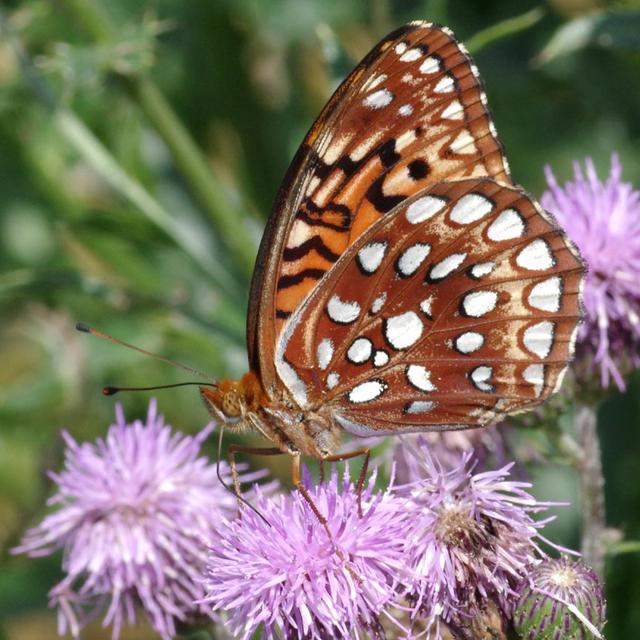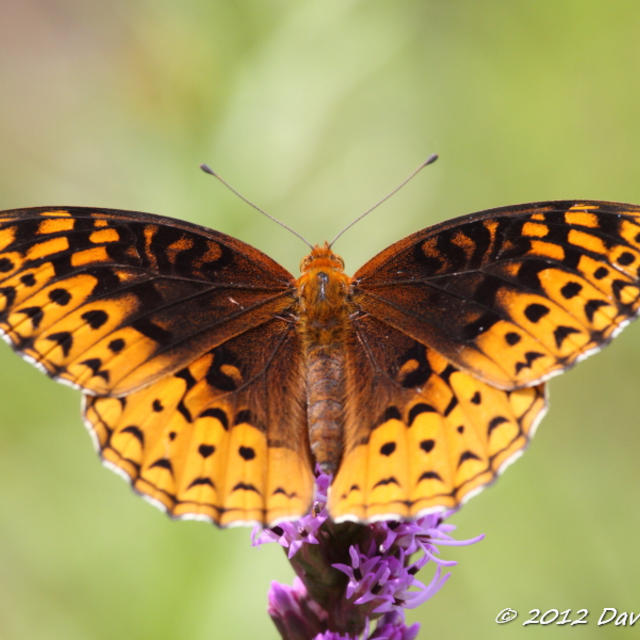Aphrodite Fritillary
Speyeria aphrodite (Fabricius, 1787)
Family: Nymphalidae
Subfamily: Heliconiinae
Identification: Geographically variable. Upperside reddish orange-brown; male forewing with black spot below cell and with no black scales on veins. Underside of hindwing has pale submarginal band narrow or missing.
Wing Span: 2 1/2 - 3 1/4 inches (6.3 - 8.3 cm).
Life History: Males patrol for females during warm hours. Females walk about on the ground to lay single eggs near violets. First-stage caterpillars do not feed, but overwinter until spring, when they eat young leaves of violets.
Flight: One brood from mid-June to mid-September.
Caterpillar Hosts: Various violet species including northern downy violet (Viola fimbriatula) and lance-leaved violet (V. lanceolata).
Adult Food: Nectar from flowers of milkweed and viper's bugloss, among others.
Habitat: Moist prairies, high mountain meadows, openings in barrens, brushland, dry fields, open oak woods, bogs.
Range: Canada south of the taiga from Nova Scotia west through the northern Midwest and Great Plains to the Rocky Mountains, then south in the mountains to east-central Arizona and northern New Mexico; south in the Appalachians to northern Georgia.
Conservation: Not usually required.
NCGR: G5 - Demonstrably secure globally, though it may be quite rare in parts of its range, especially at the periphery.
Management Needs: None reported.
Get your BAMONA Gear!
Please donate!
We depend on donations to keep Butterflies and Moths of North America freely available. We want to express our gratitude to all who showed their support by making a contribution this year. You can donate to support this project at any time.
Advertise with us!
Do you have a product or service that you think would interest BAMONA users? If you would like to advertise on this website, contact us by email, or use the contact form and select the "Advertising" category.
Verified Sightings
Displaying 25 - 48 of 2266 verified sightings

Observation date: Aug 02, 2023
Submitted by: tjunderwood
Region: Berkshire County, Massachusetts, United States
Verified by: jwileyrains
Verified date: Aug 11, 2023

Observation date: Jul 28, 2023
Submitted by: John Terpstra
Region: Ontario, Canada
Verified by: jmgesell
Verified date: Aug 03, 2023

Observation date: Jun 30, 2017
Submitted by: Puccini
Region: Roberts County, South Dakota, United States
Verified by: J_Martineau
Verified date: Jul 28, 2023

Observation date: Jul 16, 2023
Submitted by: Lyle R
Region: Boulder County, Colorado, United States
Verified by: mikefisher
Verified date: Jul 25, 2023

Observation date: Jul 08, 2023
Submitted by: CheddahCurt
Region: Alberta, Canada
Verified by: Paul Prappas
Verified date: Jul 25, 2023
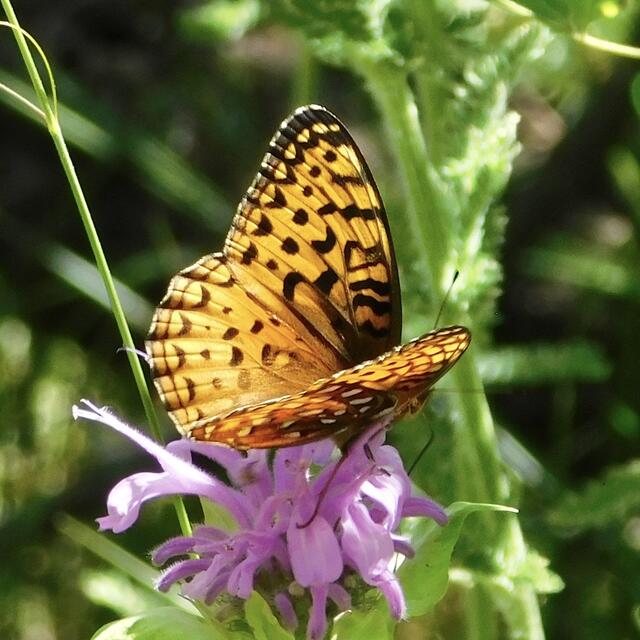
Observation date: Jul 23, 2023
Submitted by: DeepSkyKelly
Region: Colfax County, New Mexico, United States
Verified by: stevecary
Verified date: Jul 24, 2023

Observation date: Jul 23, 2023
Submitted by: DeepSkyKelly
Region: Colfax County, New Mexico, United States
Verified by: stevecary
Verified date: Jul 24, 2023

Observation date: Jul 13, 2023
Submitted by: jmgesell
Region: Monroe County, Pennsylvania, United States
Verified by: davidwright
Verified date: Jul 19, 2023

Observation date: Jul 10, 2023
Submitted by: Sometimes
Region: Ontario, Canada
Verified by: jmgesell
Verified date: Jul 10, 2023
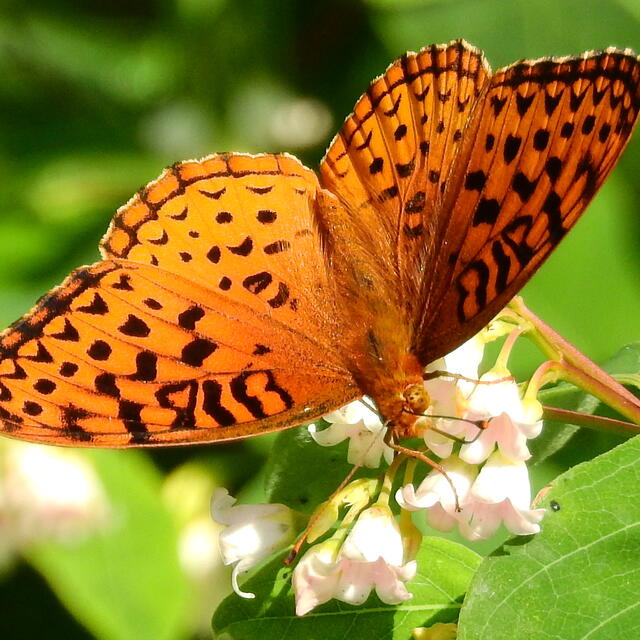
Observation date: Jul 05, 2023
Submitted by: Tom Dudones
Region: Essex County, New York, United States
Verified by: jmgesell
Verified date: Jul 07, 2023

Observation date: Jul 04, 2023
Submitted by: tjay13
Region: Union County, New Mexico, United States
Verified by: stevecary
Verified date: Jul 05, 2023

Observation date: Jul 01, 2023
Submitted by: Eddie Wyatt
Region: Lebanon County, Pennsylvania, United States
Verified by: davidwright
Verified date: Jul 04, 2023

Observation date: Jun 30, 2023
Submitted by: bonfrey
Region: Colfax County, New Mexico, United States
Verified by: stevecary
Verified date: Jul 02, 2023

Observation date: Jun 17, 2023
Submitted by: hockeybruce7
Region: Monroe County, Pennsylvania, United States
Verified by: davidwright
Verified date: Jun 19, 2023

Observation date: Aug 28, 2022
Submitted by: heinert
Region: Burleigh County, North Dakota, United States
Verified by: stevekohler
Verified date: Apr 24, 2023

Observation date: Jun 21, 2021
Submitted by: Seth Mueller
Region: Sauk County, Wisconsin, United States
Verified by: jmgesell
Verified date: Feb 18, 2023

Observation date: Aug 14, 2022
Submitted by: Hira Walker
Region: Rio Arriba County, New Mexico, United States
Verified by: stevecary
Verified date: Feb 04, 2023

Observation date: Aug 07, 2022
Submitted by: hockeybruce7
Region: Monroe County, Pennsylvania, United States
Verified by: davidwright
Verified date: Feb 04, 2023
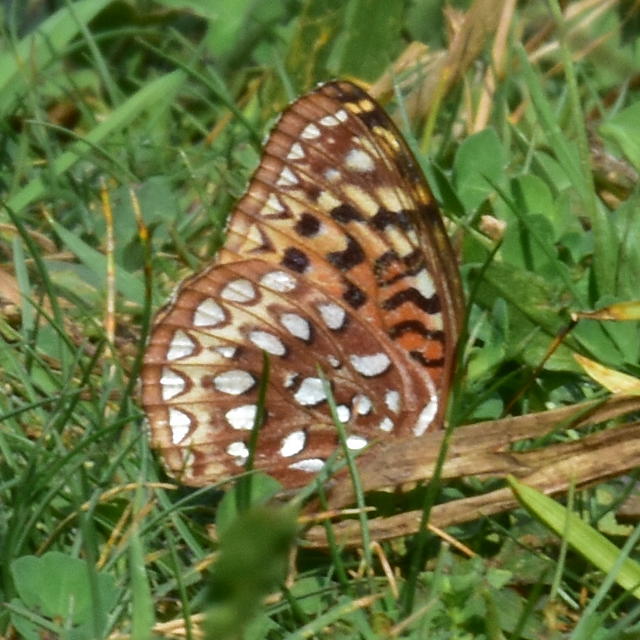
Observation date: Sep 04, 2022
Submitted by: hockeybruce7
Region: Monroe County, Pennsylvania, United States
Verified by: davidwright
Verified date: Dec 30, 2022

Observation date: Jul 16, 2022
Submitted by: Cardinal52
Region: Marathon County, Wisconsin, United States
Verified by: jmgesell
Verified date: Oct 24, 2022

Observation date: Sep 05, 2022
Submitted by: Cascade Colors
Region: Jefferson County, Colorado, United States
Verified by: mikefisher
Verified date: Oct 15, 2022

Observation date: Aug 25, 2022
Submitted by: Cascade Colors
Region: Jefferson County, Colorado, United States
Verified by: mikefisher
Verified date: Sep 28, 2022

Observation date: Jul 16, 2022
Submitted by: chneal
Region: Los Alamos County, New Mexico, United States
Verified by: stevecary
Verified date: Sep 19, 2022

Observation date: Sep 01, 2022
Submitted by: ian pepper
Region: Essex County, Massachusetts, United States
Verified by: jwileyrains
Verified date: Sep 01, 2022
- ‹ previous
- 2 of 95
- next ›





